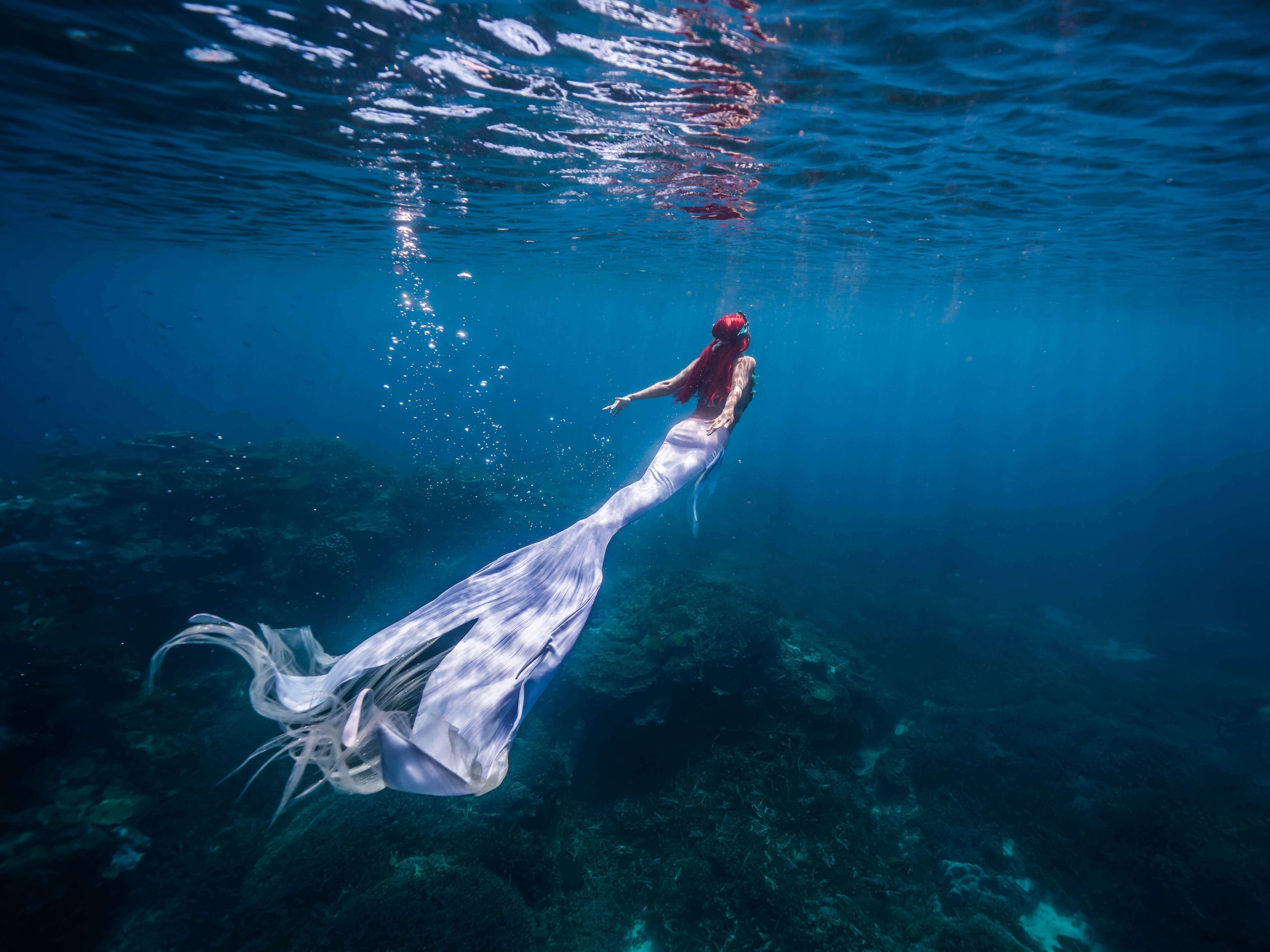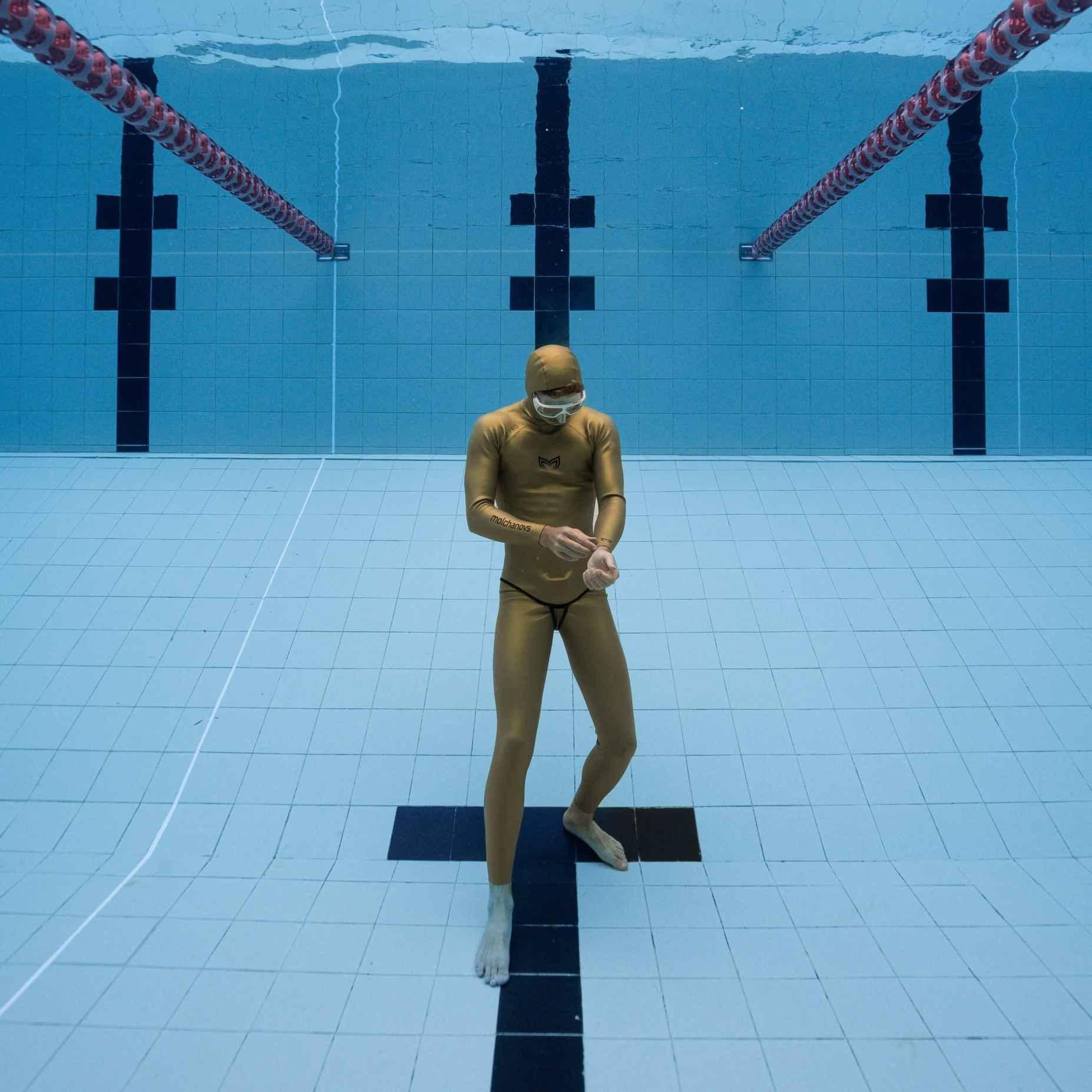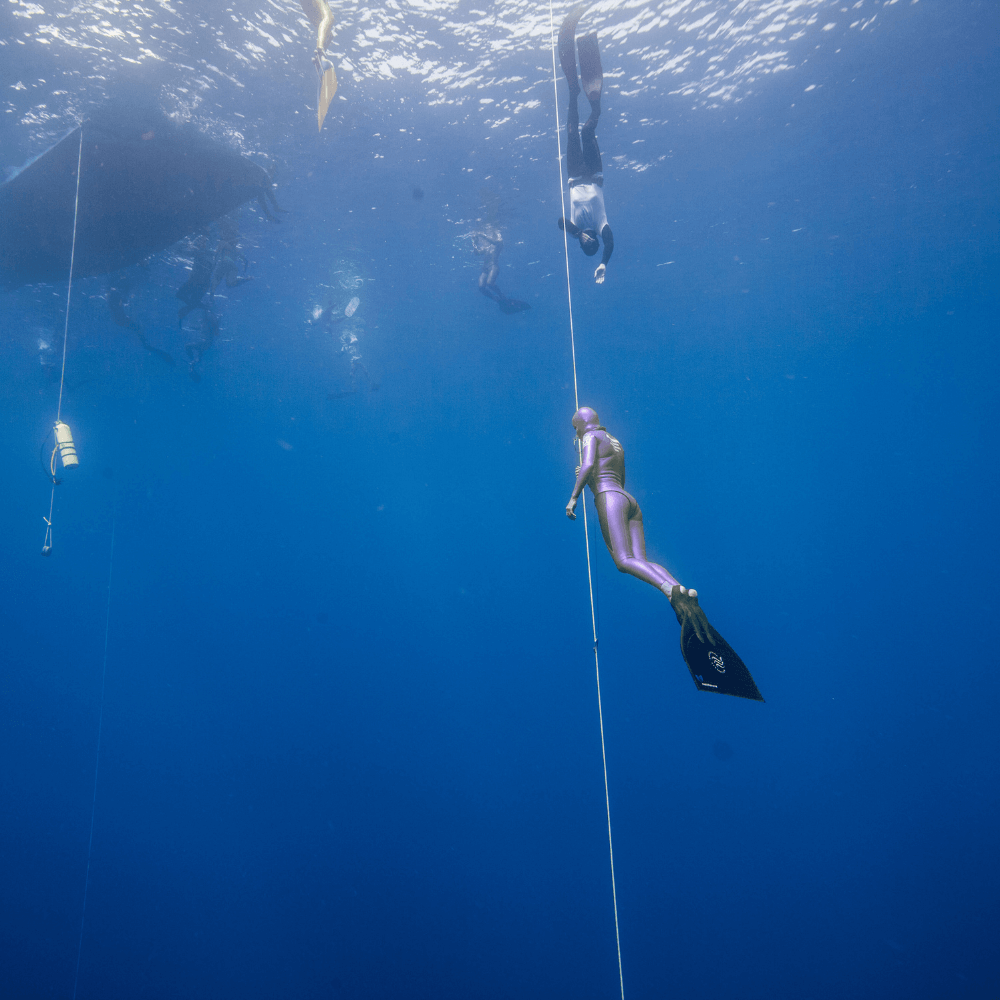What Makes a Professional Mermaid: Interview with Dominique Abraham

By Kristina Zvaritch
Did you catch Disney’s The Little Mermaid in theaters earlier this year? What if we told you that there are real-life mermaids that walk among us on land?
Dominique Abraham is one of these real-life mermaids - in fact, she’s a professional! Dominique holds her breath and performs underwater in a sequined tail, mesmerizing makeup, and costumes. She performs at private functions and even represented Australia at the 2019 World Mermaid Championship.
But most importantly, she uses her mermaid persona to get involved in ocean conservation and awareness campaigns, spreading her love and respect for the sea to those around her.
We sat down with her to learn more about mermaiding, memorable experiences, unique challenges, what she wants the public to know about mermaiding, and more!
Kristina Zvaritch: Hi Dominique! So tell me, how did you first become interested in mermaiding?
Dominique Abraham: Initially, my journey into mermaiding wasn't a conscious decision; rather, it felt like mermaiding discovered me. I was already deeply immersed in freediving as a passionate hobby when the opportunity to become a mermaid performer presented itself at Seaworld in Gold Coast, Australia. I went for the audition with no prior experience wearing a mermaid tail, but surprisingly, I perfectly fitted the silicone tail. My background in performance arts and freediving paved the way for my career in mermaiding.
Since then, I've become a Molchanovs freediving instructor and mermaid instructor.
KZ: Okay, so freediving came first! And how do you feel when you’re performing as a mermaid - what do you want the audience to feel?
DA: When I slip into the mermaid tail, it's as if I've acquired superpowers, transporting me to a magical underwater realm where the unimaginable becomes real. During mermaid performances, we don't wear masks or nose clips - the audience can see us clearly while we rely on our vivid imagination to connect with them while performing.
My hope is that this connection transcends the glass barrier and touches the audience's hearts, inspiring them to be guardians of the oceans and dream of becoming mermaids themselves one day.
KZ: That definitely sounds memorable. Can you share your own particularly memorable experience or interaction you've had while performing as a mermaid?
DA: One unforgettable moment while performing as a mermaid occurred on Lady Elliot Island, a coral cay 80km off the east coast of Australia. During a mermaid photoshoot, a huge and curious green turtle swam into the frame to investigate me. Underwater, I could see the turtle approaching, and as we surfaced together, both the turtle and myself took some breaths together. We then continued to dive together, creating a mesmerizing image of a mermaid and a turtle sharing a moment of wonder.
KZ: Wow, what an experience! And how do you choose or design your mermaid costumes and tails?
DA: The choice and design of my mermaid costumes and tails largely depend on the specific event and the persona I want to embody. For kids' mermaid parties in a pool, I aim for vibrant colors and sparkles. When performing underwater, I opt for streamlined costumes with minimal frills. And for photoshoots, I choose glamorous and eye-catching outfits.

Photo by Ash Embi
KZ: Sounds absolutely captivating! Now how does your freediving training complement your mermaiding?
DA: Freedive training complements mermaiding by providing a strong foundation in essential skills such as breath control, breath-hold techniques, equalizing underwater, mindfulness, relaxation methods, and safe breath-hold practices.
KZ: That makes sense. Then what would you say is the most challenging aspect of a mermaid performance for you, and how do you overcome it?
DA: One of the most significant challenges in mermaid performances is protecting your sinuses during tricks that involve tilting your head backward or performing flips. To overcome this, I recommend training with a nose clip to safeguard your nasal cavity from water intrusion. Initially, practice the mermaid tricks with a nose clip, and once you've perfected them, practice blowing air out of your nose as your head tilts backward. After your water session, use a sterilized saltwater nasal spray to clean your sinuses and prevent infections.
KZ: That’s interesting because I always wondered if mermaids used some kind of nose clips or plugs. Is this an option?
DA: While some mermaids use plastic nostril plugs that insert at the base of the nostrils, these can present challenges. Sizing can be difficult for your nostril shape, and your nose can also appear a lot larger than usual. Additionally, they may not provide sufficient pressure resistance for equalizing at greater depths, making them less helpful for serious mermaiding endeavors.
Safeguarding your sinuses is a crucial aspect of mermaid performances. By incorporating nose clip training, perfecting the technique of releasing air through your nose, and maintaining post-performance sinus care, you can address the challenges associated with water intrusion and enjoy a safer and more comfortable mermaid experience.
KZ: Okay, got it - thanks for clearing that up! Now, let’s talk about the mermaid community. Is it competitive, supportive, or a mix of both?
DA: The mermaid community is generally supportive and inclusive of everyone. Mermaiding is all about self-expression, and mermaids often encourage and assist one another on their mermaid journeys. Rather than being competitive, the community is composed of unique, creative individuals who share a deep belief in the magic of mermaiding.
KZ: That’s lovely! So can you tell me what mermaiding for private functions entails?
DA: Mermaiding for private functions typically involves performing in a swimming pool with an "ocean" or "under the sea" theme. I wear an elegant mermaid tail and attire, often in a seated position, to facilitate photo opportunities with guests. Following this, I perform a mermaid routine in the pool.
KZ: Sounds like a party I hope to be invited to! Earlier, you mentioned you worked at Seaworld in Australia - what was your favorite part of that?
DA: Working at Seaworld, Australia, was a fulfilling experience, particularly after the shows when children would line up to take photos with us. This presented a valuable opportunity to engage with the younger generation, emphasizing the interconnectedness of the land and the ocean. I could convey the importance of ocean conservation and inspire them to protect marine life for the future.
KZ: How fabulous! Can you tell me about your own experience in conservation and awareness campaigns as a mermaid?
DA: Yes, I've been involved in various conservation and awareness campaigns as a mermaid. A fun creative awareness project was the “Rethink Plastics” Fashion Awards. It was on the catwalk - I performed and brought the message across of how devastating the future looks for the plastic pollution problem if we don’t act now. My sequinned tail was converted to a mermaid collar and crown, and I had a long, exquisite train behind me made of collected rubbish plastics from our local area.
I am also involved in local marine park conservation projects called “Mission Blue Hope Spot” and also tree plantings and regeneration of soils along coastal catchment areas in Australia.
 Photo by Chelsea Skyeater
KZ: That sounds truly inspirational. So I should ask, who are your mermaid role models or inspirations?
Photo by Chelsea Skyeater
KZ: That sounds truly inspirational. So I should ask, who are your mermaid role models or inspirations?
DA: My mermaid role model and inspiration is Hannah Fraser, originally from Australia. Two decades ago, she initiated her mermaid career in the United States since Australia had yet to establish a mermaid community. What captivated me was her remarkable performance in a film where she danced with tiger sharks in 2014. She wasn't in a mermaid tail but was body-painted with blue/grey tiger stripes, wearing knee-high black boots and long hair extensions. She had no mask or nose clip, just her, dancing on the ocean floor with enormous tiger sharks.
KZ: That sounds mesmerizing. Now, as a professional mermaid, what do you wish more people understood about the world of professional mermaiding?
DA: It's important for people to understand that professional mermaiding is far more challenging than it appears. While the image of a beautiful mermaid sitting on a rock and singing to fishermen is a classic portrayal, bringing the magic of mermaiding to life underwater demands skill, dedication, and extensive practice.
KZ: It definitely sounds challenging to me after speaking with you! What advice would you give someone aspiring to be a professional mermaid?
DA: For aspiring professional mermaids, my advice is to believe in yourself and connect with your local freediving club or community. Start by attending a freedive course and honing your underwater breath-holding skills. Then, as you progress, purchase a mermaid tail and get creative with your own unique style of dancing underwater.
KZ: Sounds like a plan! And for my last question - I know you’ve recently created the Base Training + Mermaid Training Program. Why did you create it, and what do you hope future aspiring mermaids get out of it?
DA: I created the Base Training + Mermaid Training Program with a two-fold purpose in mind. Firstly, it's a platform for me to share my extensive underwater skills and experience as a performing mermaid. Secondly, it's designed to foster and expand the mermaid community by offering a unique and creative program that engages freedivers who are curious about exploring the world of mermaiding in a fun, enjoyable, and skill-enhancing manner.
The BT+ Mermaid Training Program is not just about donning a beautiful tail and looking the part; it's about equipping aspiring mermaids with the fundamental skills necessary to excel in this underwater art form. Here's what I hope future mermaids will gain from participating in this program:
1. Foundations of Mermaiding: Participants will receive a solid foundation in mermaiding, including techniques for graceful underwater movements, maintaining buoyancy, and interacting with the underwater environment. This is essential for becoming a convincing and captivating mermaid performer.
2. Breath-holding Skills: Mermaiding often involves long periods underwater, and breath control is paramount. The program focuses on training and expanding participants' breath-holding abilities, allowing them to perform stunning routines while submerged.
3. Creative Choreography: Mermaiding is as much about storytelling as it is about swimming. The program helps participants create captivating underwater choreography that is not only visually stunning but also tells a story. This choreography can be performed solo or in collaboration with fellow mermaids, adding versatility to their performances.
4. Community and Collaboration: Being a mermaid is not just a solo endeavor; it's about being part of a vibrant and supportive community. The program encourages participants to connect with like-minded individuals, fostering a sense of camaraderie and collaboration within the mermaid community. There will also be a private Facebook group for people who purchase the program to share videos and pictures of their mermaid endeavours.
5. Fun and enjoyment: Mermaiding should be a joyful and fulfilling experience. Through the BT+ Mermaid Training Program, I aim to instill a sense of fun and enjoyment in participants as they explore their underwater abilities and creativity.
 Photo by Harry Webber
In essence, this program is a gateway to the enchanting world of mermaiding, offering a structured and comprehensive approach to learning and improving the skills required to become a professional mermaid. It's not just about appearances; it's about the art, the skills, and the community that make mermaiding a truly magical and rewarding pursuit.
Photo by Harry Webber
In essence, this program is a gateway to the enchanting world of mermaiding, offering a structured and comprehensive approach to learning and improving the skills required to become a professional mermaid. It's not just about appearances; it's about the art, the skills, and the community that make mermaiding a truly magical and rewarding pursuit.
Check out more of Dominique Abraham’s work and follow her on her social media accounts!
Instagram: @apnea_art
Facebook: @dominiqueabraham
Did you catch Disney’s The Little Mermaid in theaters earlier this year? What if we told you that there are real-life mermaids that walk among us on land?
Dominique Abraham is one of these real-life mermaids - in fact, she’s a professional! Dominique holds her breath and performs underwater in a sequined tail, mesmerizing makeup, and costumes. She performs at private functions and even represented Australia at the 2019 World Mermaid Championship.
But most importantly, she uses her mermaid persona to get involved in ocean conservation and awareness campaigns, spreading her love and respect for the sea to those around her.
We sat down with her to learn more about mermaiding, memorable experiences, unique challenges, what she wants the public to know about mermaiding, and more!
Kristina Zvaritch: Hi Dominique! So tell me, how did you first become interested in mermaiding?
Dominique Abraham: Initially, my journey into mermaiding wasn't a conscious decision; rather, it felt like mermaiding discovered me. I was already deeply immersed in freediving as a passionate hobby when the opportunity to become a mermaid performer presented itself at Seaworld in Gold Coast, Australia. I went for the audition with no prior experience wearing a mermaid tail, but surprisingly, I perfectly fitted the silicone tail. My background in performance arts and freediving paved the way for my career in mermaiding.
Since then, I've become a Molchanovs freediving instructor and mermaid instructor.
KZ: Okay, so freediving came first! And how do you feel when you’re performing as a mermaid - what do you want the audience to feel?
DA: When I slip into the mermaid tail, it's as if I've acquired superpowers, transporting me to a magical underwater realm where the unimaginable becomes real. During mermaid performances, we don't wear masks or nose clips - the audience can see us clearly while we rely on our vivid imagination to connect with them while performing.
My hope is that this connection transcends the glass barrier and touches the audience's hearts, inspiring them to be guardians of the oceans and dream of becoming mermaids themselves one day.
KZ: That definitely sounds memorable. Can you share your own particularly memorable experience or interaction you've had while performing as a mermaid?
DA: One unforgettable moment while performing as a mermaid occurred on Lady Elliot Island, a coral cay 80km off the east coast of Australia. During a mermaid photoshoot, a huge and curious green turtle swam into the frame to investigate me. Underwater, I could see the turtle approaching, and as we surfaced together, both the turtle and myself took some breaths together. We then continued to dive together, creating a mesmerizing image of a mermaid and a turtle sharing a moment of wonder.
KZ: Wow, what an experience! And how do you choose or design your mermaid costumes and tails?
DA: The choice and design of my mermaid costumes and tails largely depend on the specific event and the persona I want to embody. For kids' mermaid parties in a pool, I aim for vibrant colors and sparkles. When performing underwater, I opt for streamlined costumes with minimal frills. And for photoshoots, I choose glamorous and eye-catching outfits.

DA: Freedive training complements mermaiding by providing a strong foundation in essential skills such as breath control, breath-hold techniques, equalizing underwater, mindfulness, relaxation methods, and safe breath-hold practices.
KZ: That makes sense. Then what would you say is the most challenging aspect of a mermaid performance for you, and how do you overcome it?
DA: One of the most significant challenges in mermaid performances is protecting your sinuses during tricks that involve tilting your head backward or performing flips. To overcome this, I recommend training with a nose clip to safeguard your nasal cavity from water intrusion. Initially, practice the mermaid tricks with a nose clip, and once you've perfected them, practice blowing air out of your nose as your head tilts backward. After your water session, use a sterilized saltwater nasal spray to clean your sinuses and prevent infections.
KZ: That’s interesting because I always wondered if mermaids used some kind of nose clips or plugs. Is this an option?
DA: While some mermaids use plastic nostril plugs that insert at the base of the nostrils, these can present challenges. Sizing can be difficult for your nostril shape, and your nose can also appear a lot larger than usual. Additionally, they may not provide sufficient pressure resistance for equalizing at greater depths, making them less helpful for serious mermaiding endeavors.
Safeguarding your sinuses is a crucial aspect of mermaid performances. By incorporating nose clip training, perfecting the technique of releasing air through your nose, and maintaining post-performance sinus care, you can address the challenges associated with water intrusion and enjoy a safer and more comfortable mermaid experience.
KZ: Okay, got it - thanks for clearing that up! Now, let’s talk about the mermaid community. Is it competitive, supportive, or a mix of both?
DA: The mermaid community is generally supportive and inclusive of everyone. Mermaiding is all about self-expression, and mermaids often encourage and assist one another on their mermaid journeys. Rather than being competitive, the community is composed of unique, creative individuals who share a deep belief in the magic of mermaiding.
KZ: That’s lovely! So can you tell me what mermaiding for private functions entails?
DA: Mermaiding for private functions typically involves performing in a swimming pool with an "ocean" or "under the sea" theme. I wear an elegant mermaid tail and attire, often in a seated position, to facilitate photo opportunities with guests. Following this, I perform a mermaid routine in the pool.
KZ: Sounds like a party I hope to be invited to! Earlier, you mentioned you worked at Seaworld in Australia - what was your favorite part of that?
DA: Working at Seaworld, Australia, was a fulfilling experience, particularly after the shows when children would line up to take photos with us. This presented a valuable opportunity to engage with the younger generation, emphasizing the interconnectedness of the land and the ocean. I could convey the importance of ocean conservation and inspire them to protect marine life for the future.
KZ: How fabulous! Can you tell me about your own experience in conservation and awareness campaigns as a mermaid?
DA: Yes, I've been involved in various conservation and awareness campaigns as a mermaid. A fun creative awareness project was the “Rethink Plastics” Fashion Awards. It was on the catwalk - I performed and brought the message across of how devastating the future looks for the plastic pollution problem if we don’t act now. My sequinned tail was converted to a mermaid collar and crown, and I had a long, exquisite train behind me made of collected rubbish plastics from our local area.
I am also involved in local marine park conservation projects called “Mission Blue Hope Spot” and also tree plantings and regeneration of soils along coastal catchment areas in Australia.
 Photo by Chelsea Skyeater
Photo by Chelsea Skyeater
DA: My mermaid role model and inspiration is Hannah Fraser, originally from Australia. Two decades ago, she initiated her mermaid career in the United States since Australia had yet to establish a mermaid community. What captivated me was her remarkable performance in a film where she danced with tiger sharks in 2014. She wasn't in a mermaid tail but was body-painted with blue/grey tiger stripes, wearing knee-high black boots and long hair extensions. She had no mask or nose clip, just her, dancing on the ocean floor with enormous tiger sharks.
KZ: That sounds mesmerizing. Now, as a professional mermaid, what do you wish more people understood about the world of professional mermaiding?
DA: It's important for people to understand that professional mermaiding is far more challenging than it appears. While the image of a beautiful mermaid sitting on a rock and singing to fishermen is a classic portrayal, bringing the magic of mermaiding to life underwater demands skill, dedication, and extensive practice.
KZ: It definitely sounds challenging to me after speaking with you! What advice would you give someone aspiring to be a professional mermaid?
DA: For aspiring professional mermaids, my advice is to believe in yourself and connect with your local freediving club or community. Start by attending a freedive course and honing your underwater breath-holding skills. Then, as you progress, purchase a mermaid tail and get creative with your own unique style of dancing underwater.
KZ: Sounds like a plan! And for my last question - I know you’ve recently created the Base Training + Mermaid Training Program. Why did you create it, and what do you hope future aspiring mermaids get out of it?
DA: I created the Base Training + Mermaid Training Program with a two-fold purpose in mind. Firstly, it's a platform for me to share my extensive underwater skills and experience as a performing mermaid. Secondly, it's designed to foster and expand the mermaid community by offering a unique and creative program that engages freedivers who are curious about exploring the world of mermaiding in a fun, enjoyable, and skill-enhancing manner.
The BT+ Mermaid Training Program is not just about donning a beautiful tail and looking the part; it's about equipping aspiring mermaids with the fundamental skills necessary to excel in this underwater art form. Here's what I hope future mermaids will gain from participating in this program:
1. Foundations of Mermaiding: Participants will receive a solid foundation in mermaiding, including techniques for graceful underwater movements, maintaining buoyancy, and interacting with the underwater environment. This is essential for becoming a convincing and captivating mermaid performer.
2. Breath-holding Skills: Mermaiding often involves long periods underwater, and breath control is paramount. The program focuses on training and expanding participants' breath-holding abilities, allowing them to perform stunning routines while submerged.
3. Creative Choreography: Mermaiding is as much about storytelling as it is about swimming. The program helps participants create captivating underwater choreography that is not only visually stunning but also tells a story. This choreography can be performed solo or in collaboration with fellow mermaids, adding versatility to their performances.
4. Community and Collaboration: Being a mermaid is not just a solo endeavor; it's about being part of a vibrant and supportive community. The program encourages participants to connect with like-minded individuals, fostering a sense of camaraderie and collaboration within the mermaid community. There will also be a private Facebook group for people who purchase the program to share videos and pictures of their mermaid endeavours.
5. Fun and enjoyment: Mermaiding should be a joyful and fulfilling experience. Through the BT+ Mermaid Training Program, I aim to instill a sense of fun and enjoyment in participants as they explore their underwater abilities and creativity.
 Photo by Harry Webber
Photo by Harry Webber
Check out more of Dominique Abraham’s work and follow her on her social media accounts!
Instagram: @apnea_art
Facebook: @dominiqueabraham




Leave a comment